19 Most Common Types of Butterflies in Ohio (With Pictures)
-
Ashley Bates
- Last updated:
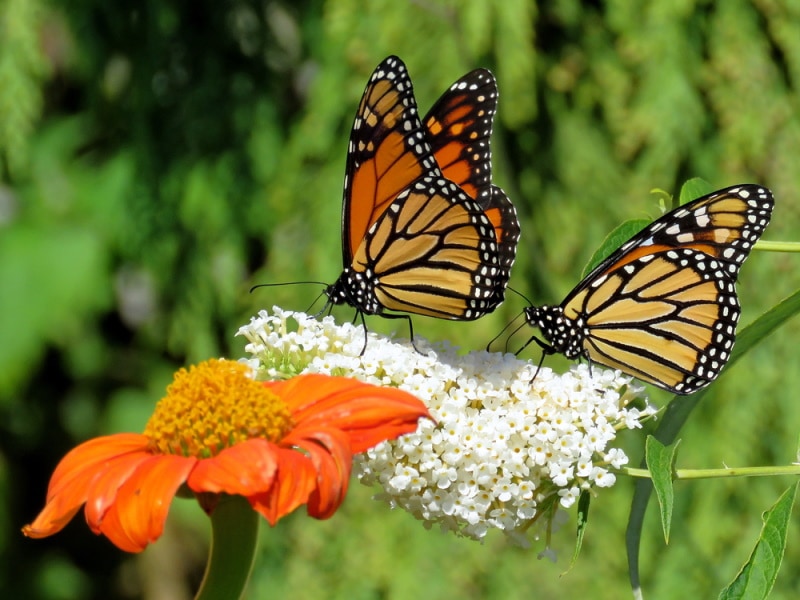
There is something about a butterfly that makes the warm seasons that much better. Butterflies are a sign of beauty; each one is unique and lovely in its own right. While we look at butterflies as creatures of beauty, it might surprise you to learn about some of their eating habits.
While several different butterfly species exist in Ohio, we rounded up 19 of the most common ones you might see in your yard, surrounding woods, or garden space.
The 19 Most Common Types of Butterflies in Ohio
1. Monarch
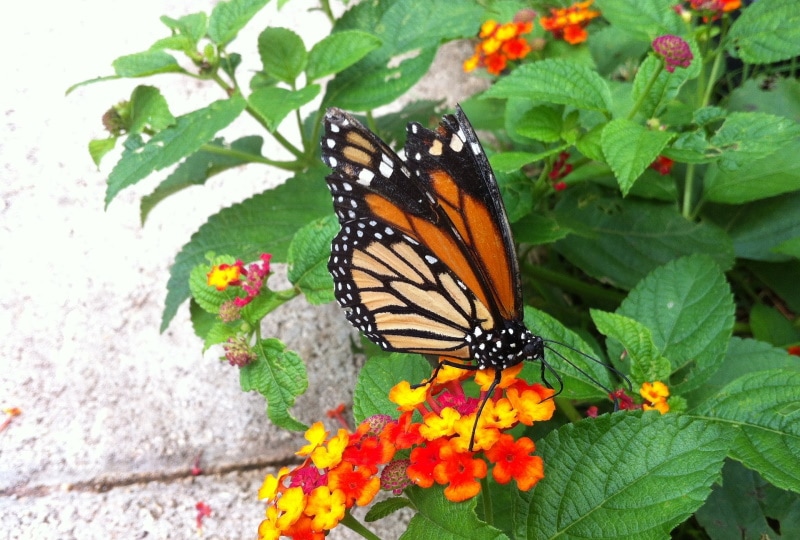
| Scientific Name | Danaus plexippus |
| Length | 4 inches |
| Environment | Forests, mountains, gardens |
A monarch might be one of Ohio’s most recognized and beloved butterflies. With their vibrant black and orange coloring, one can see it and know that this is exactly what they’re looking at. However, the monarch does have its look-alikes.
Monarchs are quite impressive travelers, sometimes flying up to 2,800 miles. They can also get quite large when fully grown, with wingspans up to four inches. While common in Ohio, they are on the endangered list.
2. American Lady
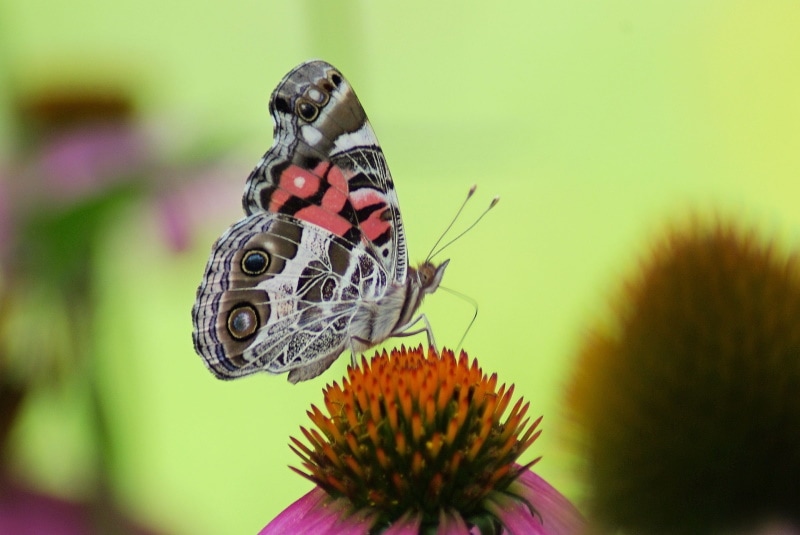
| Scientific Name | Vanessa virginiensis |
| Length | 2.4 inches |
| Environment | Forests, gardens |
The American lady might be instantly recognizable to you if you have many butterflies in your yard or garden space. You will likely see these beautiful butterflies, but their color might change depending on the season. They tend to be very vibrant colored earlier in the spring months, and in the fall, they are much paler.
The American lady can get up to 2.4 inches in length. They have a unique appearance on their wings that look like eyes to ward off potential predators. This is an evolutionary defense that many butterflies and moths have to ward off danger.
3. Hackberry Emperor
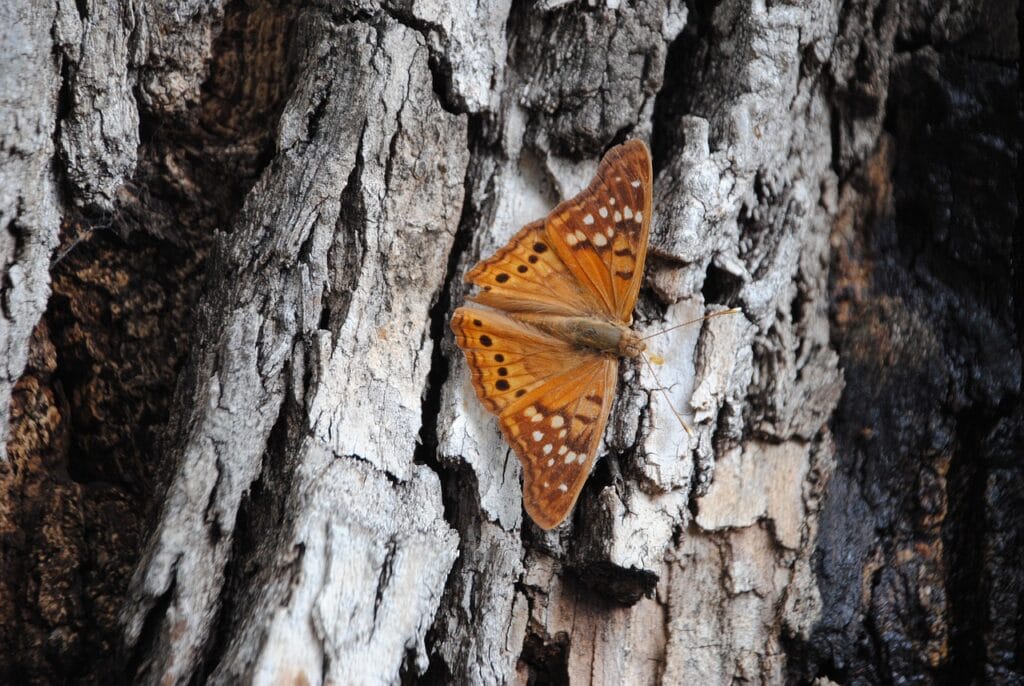
| Scientific Name | Asterocampa celtis |
| Length | 2.75 inches |
| Environment | Forests, suburban areas |
The hackberry emperor is one of the common varieties of butterflies in Ohio. One thing is for certain about the hackberry emperor – you’re not going to attract it to your garden by putting out your favorite butterfly flowers. These particular butterflies do not eat nectar.
Instead, they eat minerals from the soil, rock, and other hard natural surfaces. They also eat pretty gross substances like carrion and dung. You might even see them stopping by a local rain puddle for a little drink.
4. Red-spotted Purple

| Scientific Name | Limenitis arthemis Astyanax |
| Length | 4 inches |
| Environment | Woodlands, streams and marshes |
When you encounter the red-spotted purple butterfly, you’re probably completely overtaken by its beauty. Despite its name, the wings give off a very blue color with shimmery dark purple and red-orange spots.
This is another butterfly that does not partake in nectar-eating. They are a perfect defense against predators because their coloring mimics a poisonous butterfly called the pipevine swallowtail. This is a very good survival tactic.
Instead, they eat rotting fruit, carrion, and sap. You will generally see these beauties flying around from April to October.
5. Mourning Cloak
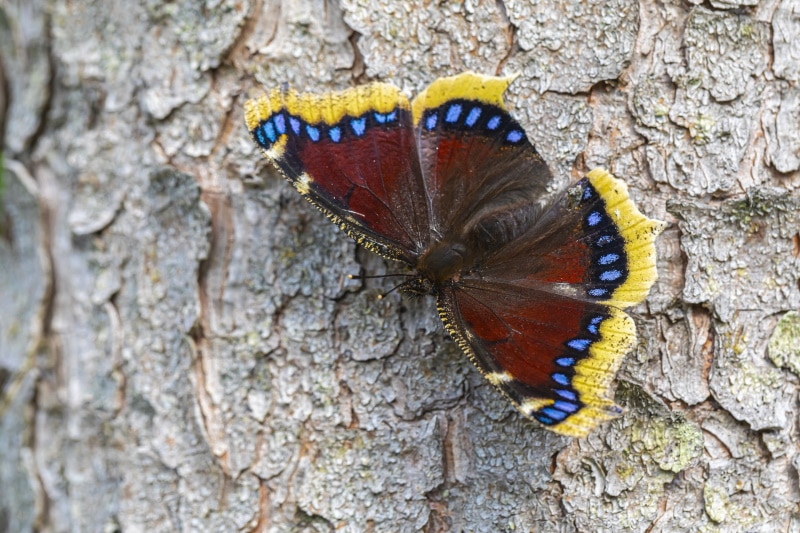
| Scientific Name | Nymphalis Antiopa |
| Length | 4 inches |
| Environment | Deciduous forests |
The beautiful mourning cloak is an all-black butterfly with iridescent qualities and a yellow border with purple dots. These butterflies are very solitary, so they might be less easy to spot. So even though they are a very common species in Ohio, they might be one of the least easy to detect.
These beauties are the very first butterflies to become active in the spring months. Some of them might even be spotted in the winter months, permitting the weather is warm enough that day. In addition to their environmental adaptability, a single mourning cloak butterfly can live as long as ten months making it one of the longest-lived butterflies of all.
6. Pearl Crescent

| Scientific Name | Phyciodes tharos |
| Length | 1.75 inches |
| Environment | Meadows, gardens |
The pearl crescent butterfly is often compared to lace because of its beautiful markings. They are generally vibrant orange with black borders and spots. These butterflies gravitate towards a specific type of flower, the aster plant.
So, if you want to attract more of these beauties to your garden space, this is a terrific flower to pick, although they will gravitate towards some others as well. Since they do not feed on decay, they are definitely a garden variety of butterflies that you can attract to your home space, and they’re very easy to spot.
7. Eastern Comma
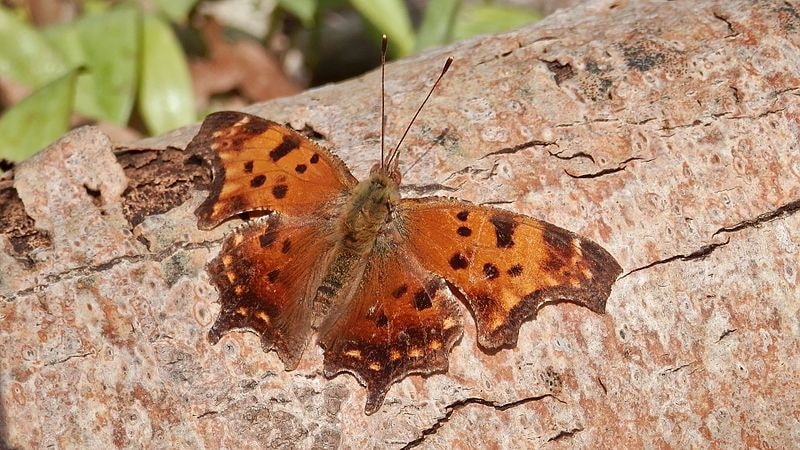
| Scientific Name | Polygonia comma |
| Length | 2.5 inches |
| Environment | Deciduous forests, suburban areas |
The eastern comma has a fascinating wing shape, almost looking like it was cut from paper. These butterflies have a nearly kaleidoscopic look with tones of orange, neutrals, and black.
Despite the fact that they are beautiful, and you probably want to see them lingering around your house, these butterflies are most attracted to animal dung and carrion, making them incompatible with garden spaces.
8. Common Buckeye

| Scientific Name | Junonia coenia |
| Length | 2.75 inches |
| Environment | Pastures, meadows |
The common buckeye butterfly is neutral with very bright pops of color, including purple and orange. They have prominent eye markings on their wings to ward off predators, and they can carry a much broader spectrum of color depending on the butterfly.
Something interesting about these particular butterflies is that they do not have a specific mating season. They are capable of reproducing year-round. Since they prefer open territories, it is very understandable that evolution led them to have these eye-like markings on them to evade potential threats in easily visible spots.
9. Great Spangled Fritillary
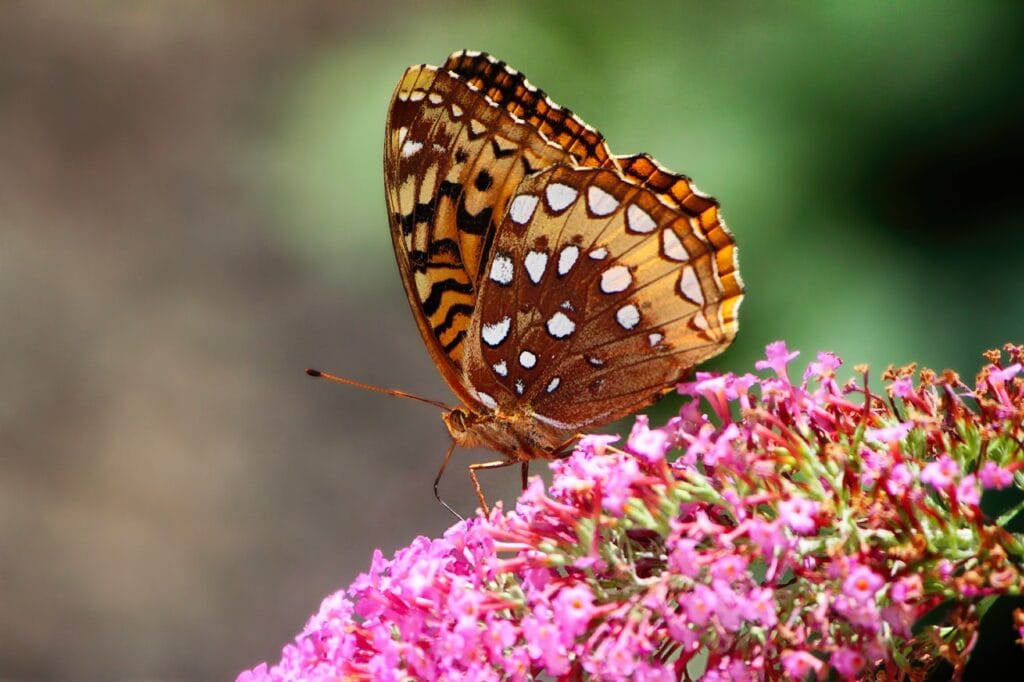
| Scientific Name | Speyeria Cybele |
| Length | 3.5 inches |
| Environment | Fields, meadows |
The great spangled fritillary is a bold and beautiful butterfly that loves field living. You can see them in meadows, pastures, and gardens. They’re especially fond of milkweed and violets. So, if you’d like to attract these particular butterflies to your garden space, having these two beautiful plants on hand will guarantee a visit from these pretty critters.
The great spangled fritillary has a somewhat tragic reproductive cycle. The males die immediately after mating. The females go on to feed for a few more weeks before dying off themselves. They have short lifespans once they have grown wings, but caterpillars can hibernate over the winter.
10. Aphrodite Fritillary
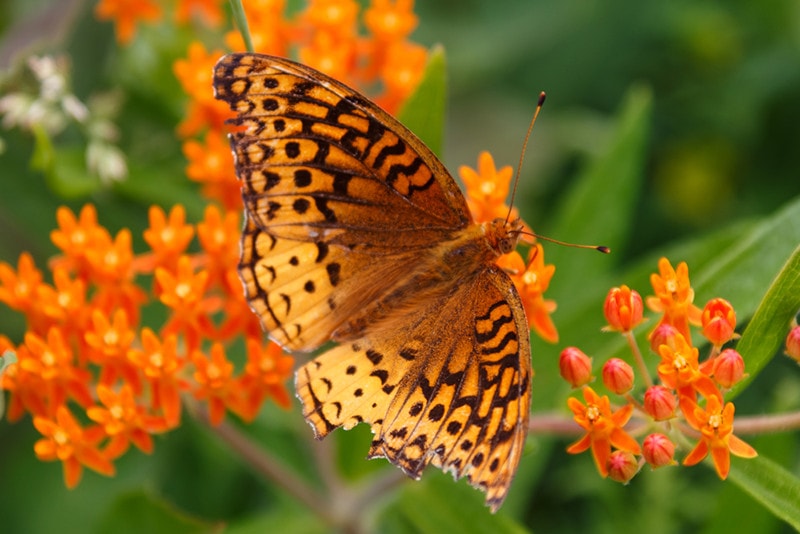
| Scientific Name | Speyeria Aphrodite |
| Length | 3 inches |
| Environment | Fields, meadows |
Like their other fritillary cousins, the Aphrodite fritillary absolutely loves the Violet plant. The caterpillars use the violet plants to hibernate, and adults love to feed on the flowers.
In fact, these particular butterflies will find Violet plants and lay their eggs around them.
This gorgeous butterfly with bright yellowish orange wings also feeds on various other plants. These include thistles, goldenrod, and butterfly weed. So these are definitely an easy selection to attract to your garden space.
11. Common Wood Nymph
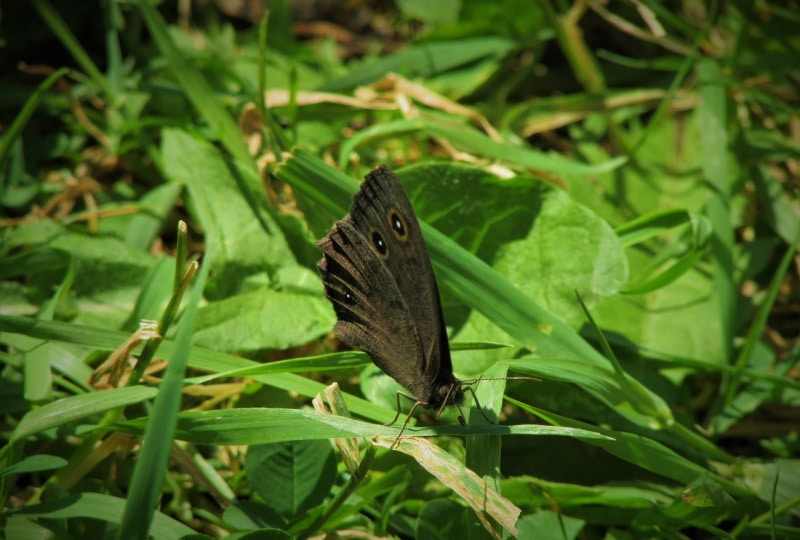
| Scientific Name | Cercyonis pegala |
| Length | 3 inches |
| Environment | Open forests, fields, marshes |
The wood nymph is a very dark brown butterfly with eye-like markings on their wings. These butterflies inhabit open forests and meadows, but they can also be seen in fields and marshes. These butterflies sometimes eat flower nectar, but they gravitate mostly towards decaying plant matter.
This is one of the only butterflies in Ohio that feed on grass while in the Caterpillar state. Because they like to munch on grass and are not picky about the type they eat, you might find them in your yard even if you don’t live in the country.
12. Little Wood Satyr
| Scientific Name | Megisto cymela |
| Length | 2 inches |
| Environment | Woodlands, brushy areas, meadows |
The little wood satyr is a neutral-colored butterfly that tends to gravitate towards woodland areas. If you spot one of these butterflies, you might notice that they fly very low to the ground and perch mostly in grasses.
This butterfly is vital in its habitat as it eats animal waste, rotting floor fungus, and sap that flows from trees. Because of its particular dietary needs, they are not nearly as common to see in the garden space unless you live in a heavily wooded area.
13. American Snout

| Scientific Name | Libytheana carineta |
| Length | 2 inches |
| Environment | Woodlands, open fields |
The American snout is a unique addition to add to the list. These butterflies are scarce to see because they are so well camouflaged and look like dead leaves. But often, when you do see these butterflies, they fly in migratory groups. So, you might see an abundance of them at one time.
The Americans now got its name due to its long beak-like snout. This is another addition to this butterfly’s body to make it resemble dead leaves. It has a great camouflaging system and can be very hard to detect, even for experienced watchers.
14. Azure
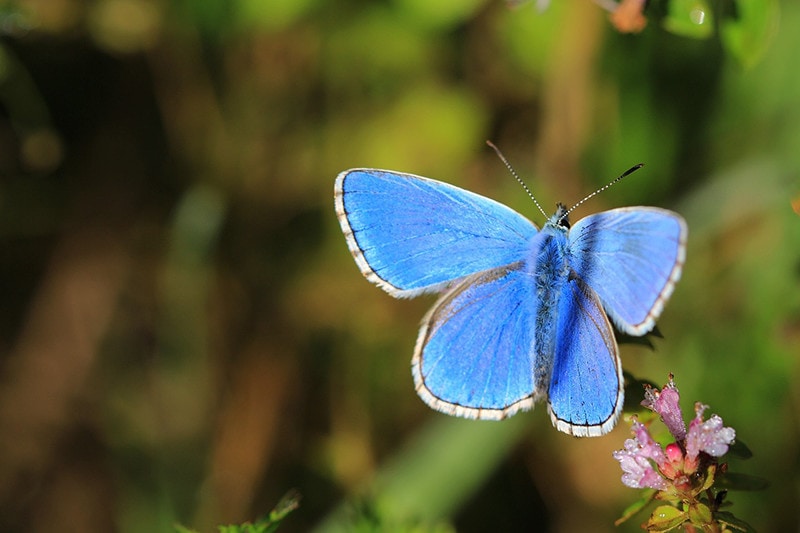
| Scientific Name | Celastrina ladon |
| Length | 1.25 inches |
| Environment | Hiking trails, open woodlands, meadows |
You sure will know the Azure butterfly when you see it. These cornflower blue little butterflies are instantly recognizable. Even though both species are pale gray to lavender in color, the females tend to be darker than the males.
These abundant butterflies are very recognizable and easily seen in the summer months. Often, these particular butterflies herald in a new spring, being one of the first butterflies of the season to show their colors.
15. Gray Hairstreak

| Scientific Name | Strymon melinus |
| Length | 1.5 inches |
| Environment | Pastures, meadows |
The gray hairstreak touts a dark gray on top with lighter gray underneath and orange and black eye-like markings. These butterflies have thin strings dangling from each of their wings, making them a very rare sight to behold. Even though it looks aesthetically pleasing,
It’s actually a defense strategy to deflect potential predators. Even though these butterflies are pretty bold, they do not get very big. These butterflies are common in all the United States.
16. American Copper
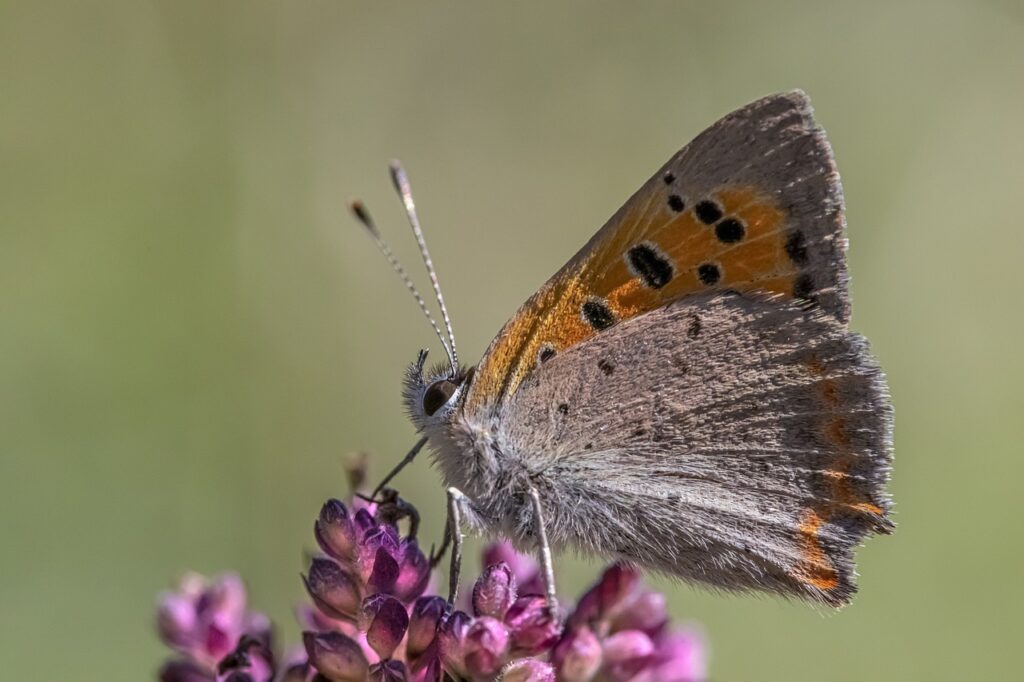
| Scientific Name | Lycaena phlaeas |
| Length | 1.5 inches |
| Environment | Meadows, fields |
The American copper butterfly is a beautiful butterfly and one of the most common in Ohio. These smaller beauties can withstand the winters of northern states like Ohio, but they are generally active from June to September.
The American copper is in the family of gossamer-winged butterflies, which contains several 100 species of their own. This is just one of the many looks of these smaller butterflies that you might see fluttering around in the warmer months.
17. Eastern Tiger Swallowtail
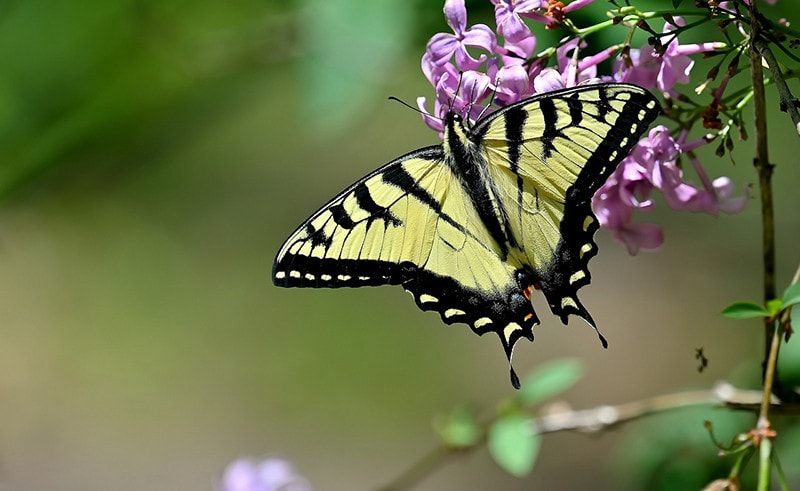
| Scientific Name | Papilio glaucus |
| Length | 5.5 inches |
| Environment | Meadows, open fields, gardens |
You might instantly recognize the eastern tiger swallowtail. These beautiful butterflies can be anywhere from yellow to black in color and have classic elongated wings. The eastern tiger swallowtail stays with its kind, even swarming together.
They have enormous eyespots that will deter predators from messing with them, and they tend to get very large in size. These specific types of butterflies can eat some decay, but they prefer to feed on flowers like lilac and phlox.
18. Spicebush Swallowtail
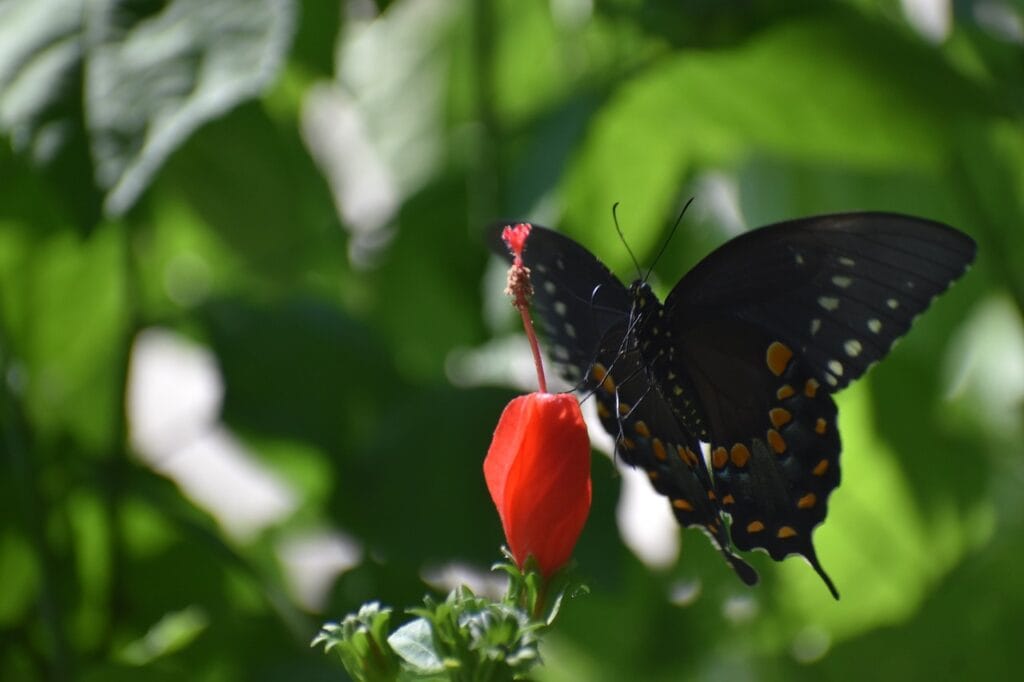
| Scientific Name | Papilio Troilus |
| Length | 4 inches |
| Environment | Forests, swamps, fields |
The spicebush swallowtails look a lot like the eastern tiger swallowtail, but these butterflies are mostly black with vibrant blue on their wings. You can enjoy these butterflies throughout the warm seasons as they are prevalent from spring to fall.
These butterflies mainly like feasting on nectar-rich plants, particularly jewelweed. Because the spicebush swallowtail is active in colder seasons, they can change their body temperature to regulate themselves during these fluctuations.
19. Cabbage White
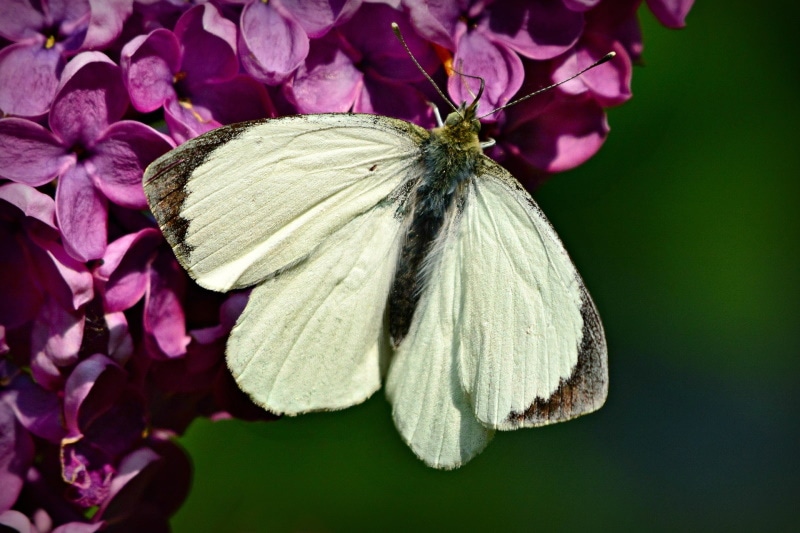
| Scientific Name | Pleris Rapae |
| Length | 2 inches |
| Environment | Suburban, metropolitan, meadows, fields |
The cabbage white butterfly is another selection on the list that you might instantly recognize. These little guys are very common in urban to rural areas. They tolerate Ohio weather and can thrive in various living situations.
These butterflies prefer open spaces rather than wooded or brushy habitats. Surprisingly, the cabbage white is considered an invasive butterfly species, and they will definitely feed on the veggies you have growing in your garden.
Final Thoughts
Butterflies are graceful creatures, and their life stages are so unique. There are several more butterfly species in Ohio to admire. But these are the most common ones you might see fluttering around on a warm day.
Hopefully, you have identified many of the butterflies on this list and learned something new about ones you might not have seen yet.
Featured Image Credit: emkaplin, Shutterstock
Contents
